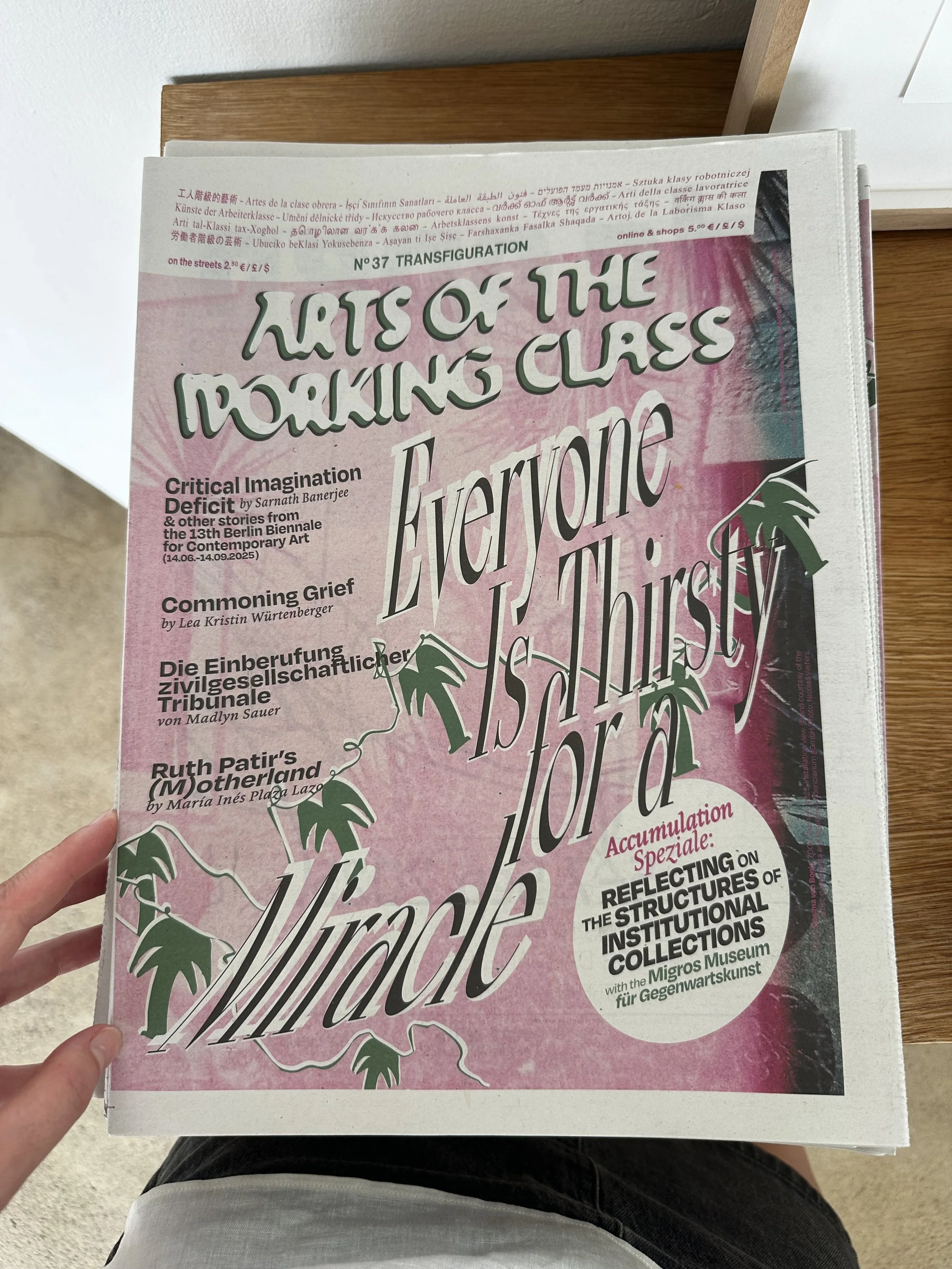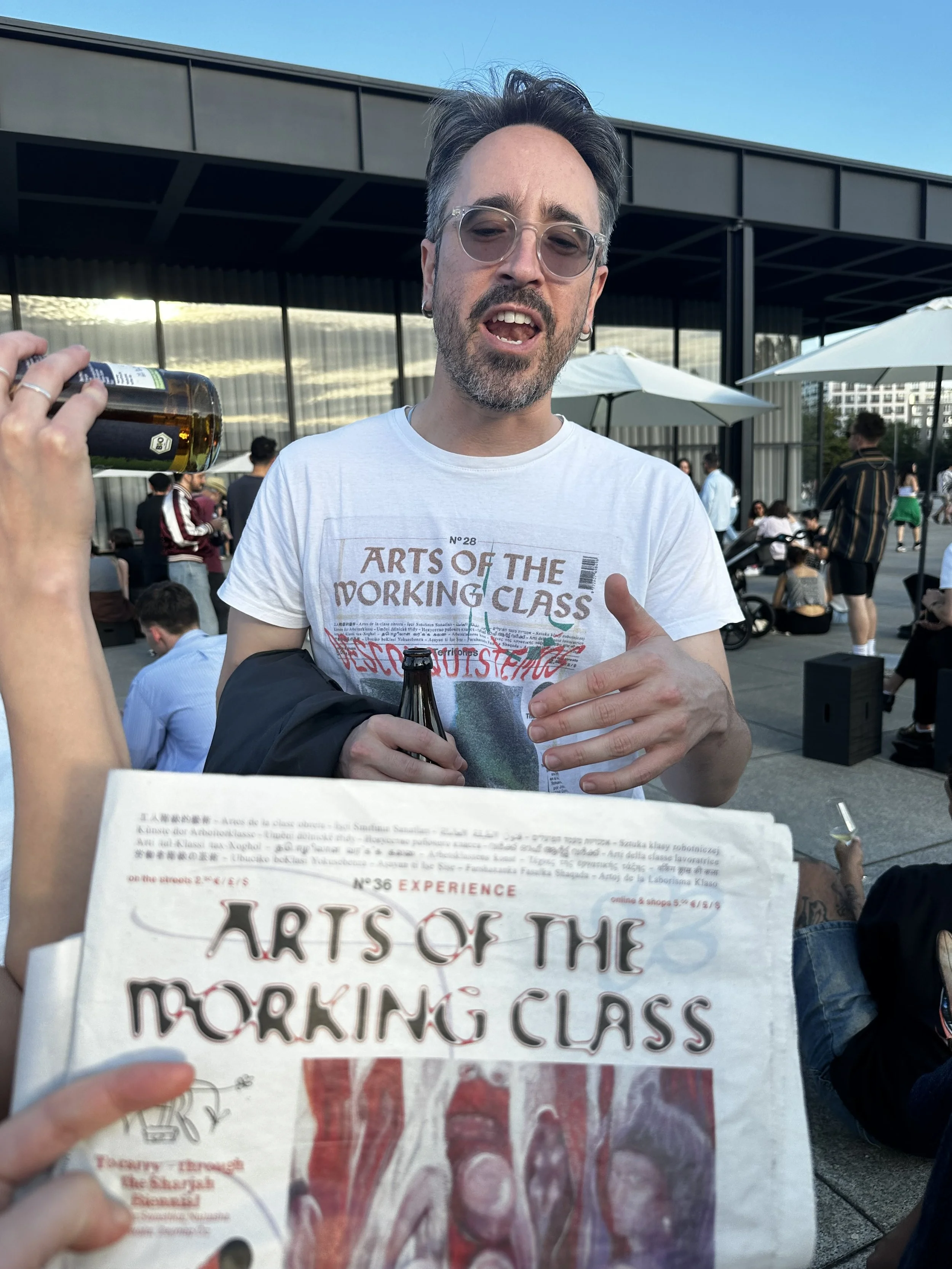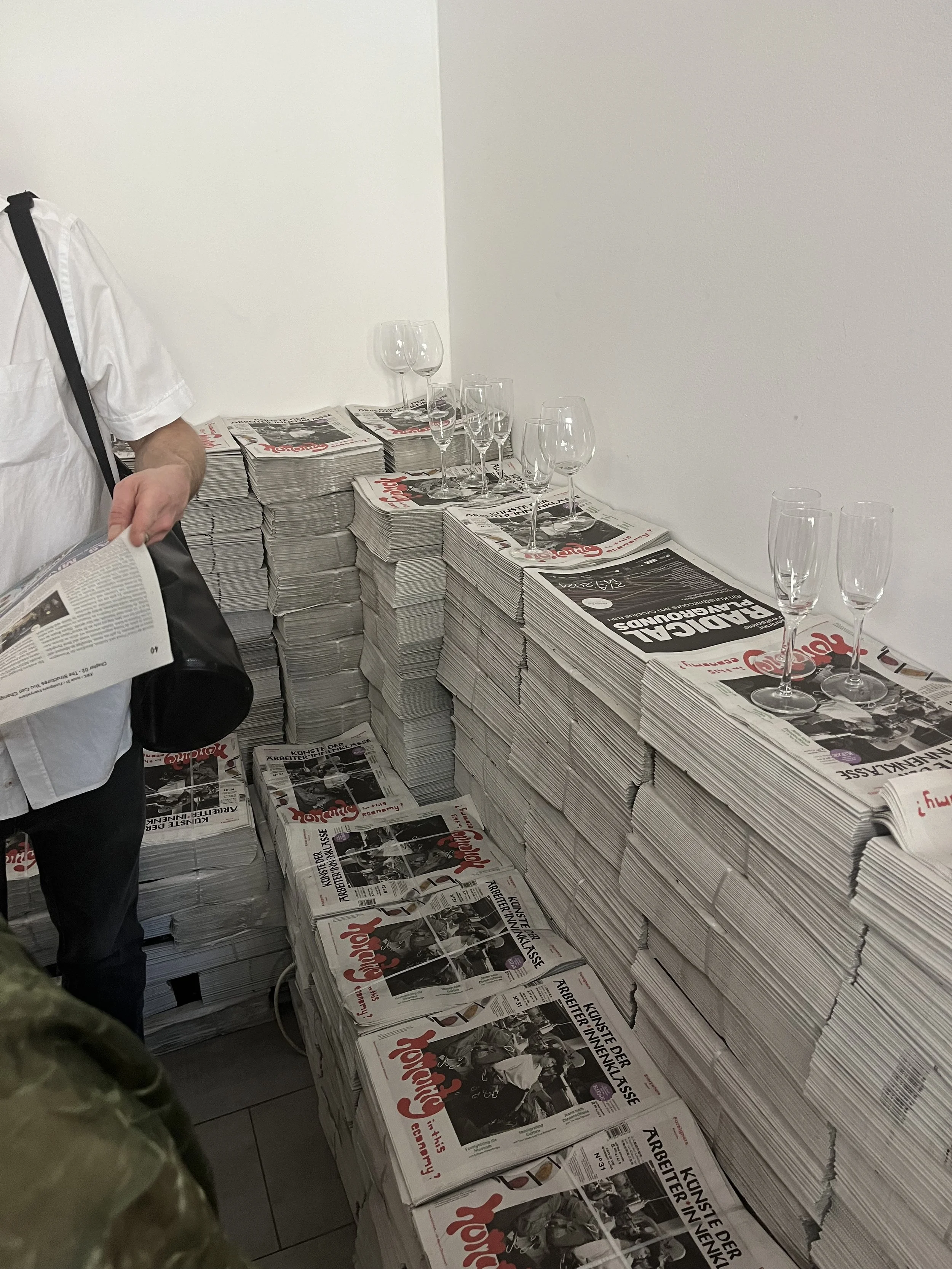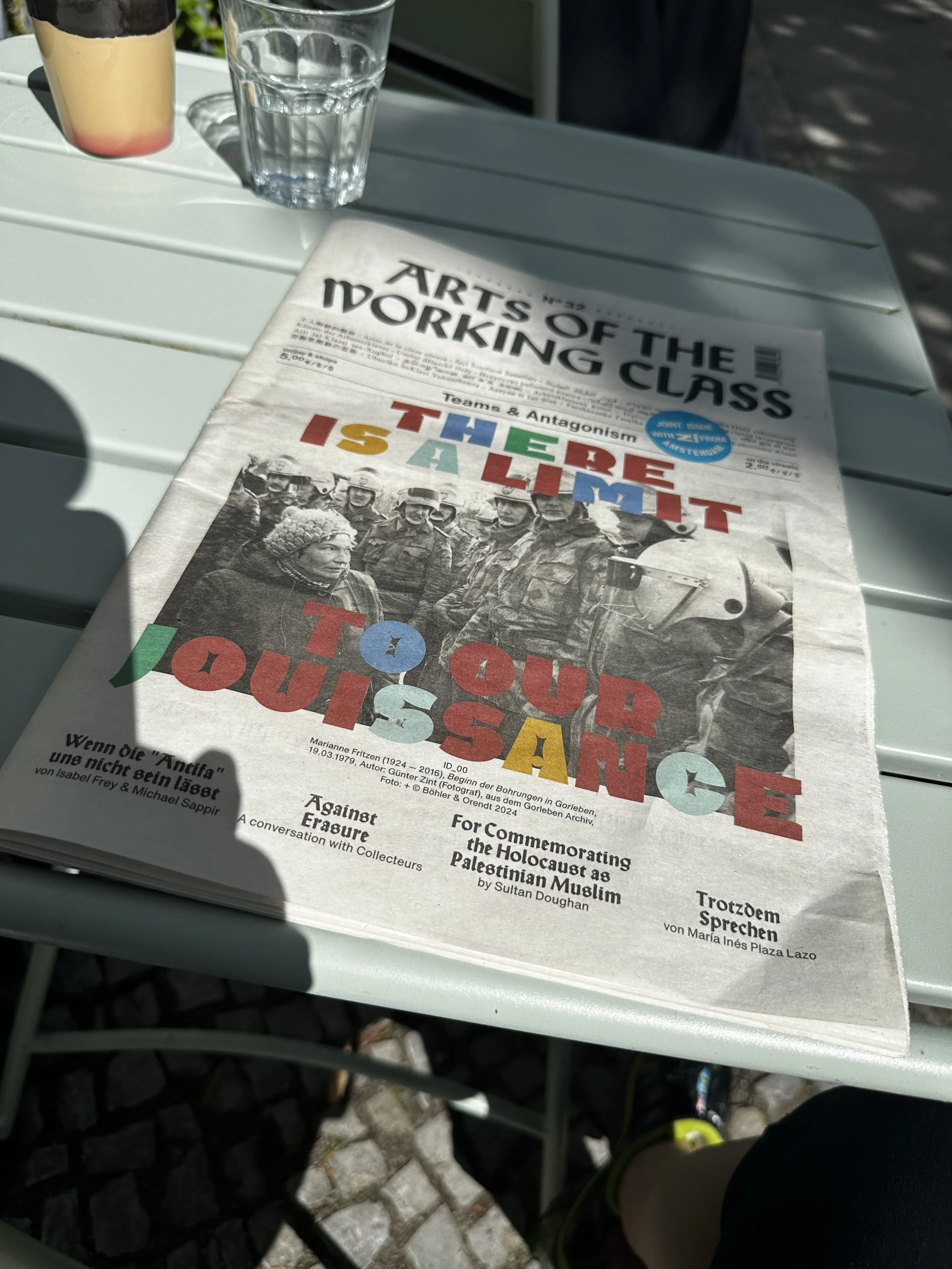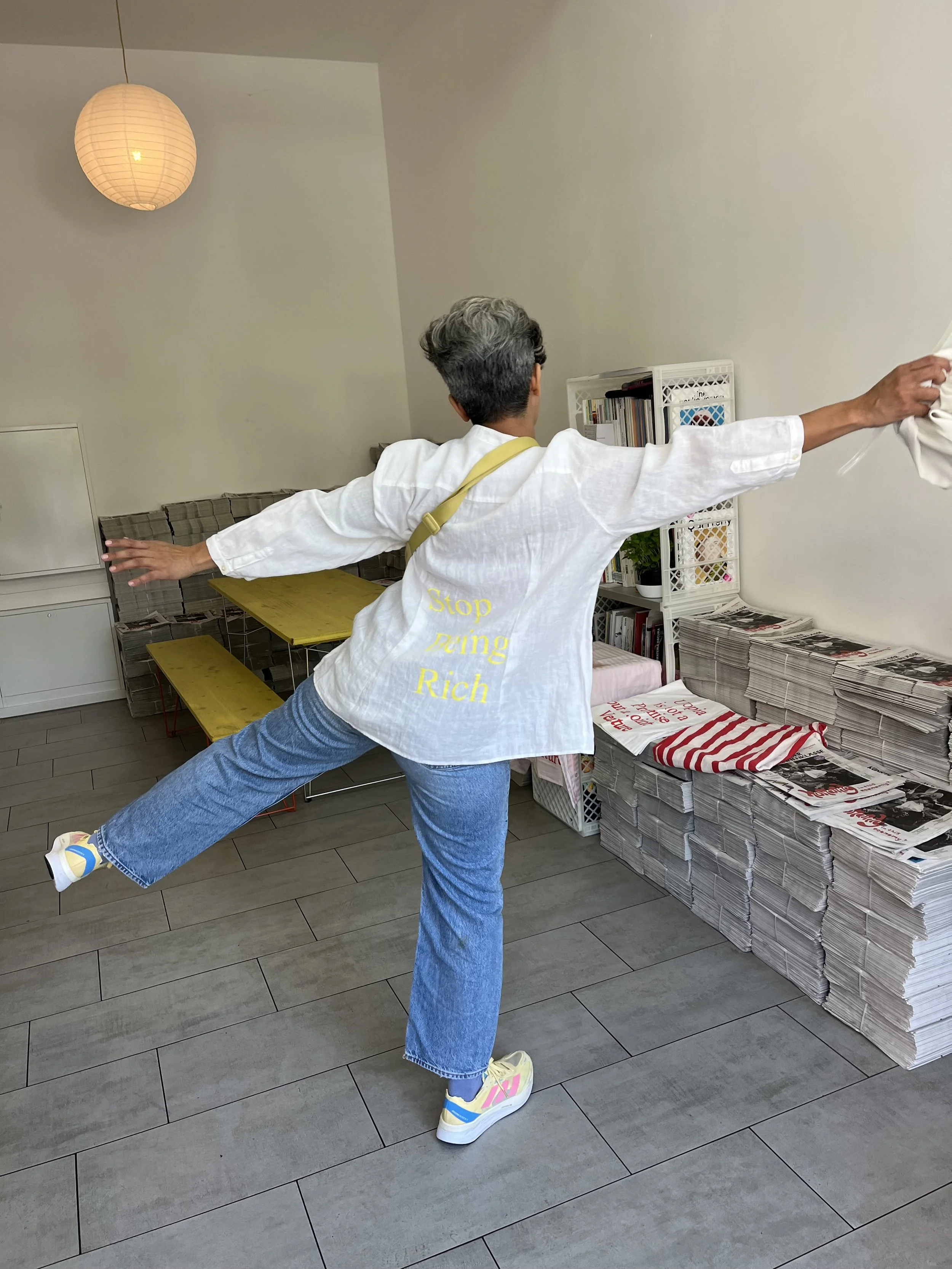María Inés Plaza Lazo's Guide to Düsseldorf
María Inés Plaza Lazo with wallpaper by Philip Wiegard in Dreams That Money Can Buy at Schloss Gandegg, Bolzano, Italy. Photo: Ché Zara Blomfield.
María Inés Plaza Lazo is a curator, publisher, and co-founder of Arts of the Working Class—a widely respected street paper reaching over 100,000 readers across Europe and beyond.
From Guayaquil, Ecuador, María Ines first made her mark in Germany with Reflektor M (2014–2017), a linchpin of Munich’s art scene, before relocating to Berlin. There, with artist Paweł Sochacki, she co-founded Arts of the Working Class, a street newspaper foregrounding the entanglements of poverty and wealth in art and society.
She moved to Düsseldorf from Berlin in 2024 with her partner Kolja Reichert, chief curator at the K21 of the Kunstsammlungen Nordrhein-Westfalen. Together, this art-world power couple—renowned for their criticism and curatorial work emanating from Germany to international audiences—have been creating new threads of conversation in the Rhineland.
Installation view of Crime as Ornament with painting by Pauł Sochacki and wallpaper by Philip WiegardCurated by María Inés Plaza Lazo at Galerie Crone, Vienna
María Inés’ curatorial endeavour include Crime as Ornament at Crone Gallery for the Curated by Festival in Vienna; artist markets during the pandemic at Souls for Foods/Music/Labor and Atelier Gardens Berlin; and the collateral intervention May the Bridges I Burn Light the Way for Manifesta 12 in Palermo.
This year’s Düsseldorf Cologne Open (DC Open) takes place from Friday, 5 to Sunday, 7 September 2025, when over 50 galleries, institutions and independent spaces will simultaneously open exhibitions across both cities. Only a 20-minute train ride apart, Düsseldorf and Cologne transform into a shared stage for contemporary art, drawing collectors, curators, artists, and visitors from across Europe.
For this year’s DC Open, María Inés has curated a program in Düsseldorf that unfolds across Velvet Collective and Malkasten Kunstverein, centred on the practice of Stav Yeini.
At Velvet Collective, Yeini’s installation remains open throughout the weekend, creating a site for embodied listening and collective attention. The program culminates from 5pm on Sunday, 7 September at Malkasten Park with closing performances by Yeini and siblings Jella&Ja Jess—coinciding with the launch of Arts of the Working Class’ newest issue.
Across both spaces, Yeini, Jella&Ja Jess trace dream fragments, invisible architectures of relation, and the possibility of reimagining community in times of rupture—offering not just a conclusion to a hectic gallery weekend, but a fragile horizon for what comes after.
We are grateful to have María Inés’ international perspective on these two Rhineland cities. ¡Gracias, amorcita!
☉Between the neighbouring art scenes, what do you recommend during the DC Open?
I am looking forward to Raphaela Vogel’s Music for Anrainer of Airports at JUBG, a virtuoso transformation of infrastructure into a site of collective attention. Also noteworthy are Kader Attia, Kai Althoff, Nairy Baghramian, and Joëlle Tuerlinckx at Galerie Nagel Draxler, whose shamanic power exposes the psychic and material legacies of colonialism, extraction, and labor exploitation.
Equally overwhelming, though in a different register, is the exhibition by Beatrix Ruf and Wade Guyton at the Langen Foundation. It makes palpable the question of what a collection can bear—not only in scale and sensibility, but also in terms of the contradictions between accumulation and display. Like the vast holdings of Michael Ringier in Zurich, such collections reveal the tension between private desire, cultural capital, and the public staging of wealth. The exhibition points to the way in which art is made to carry the surplus of capital, while institutions become the stage for its legitimation. Ringier himself will discuss the show with Silke Hohmann alongside Sabine Crassemann, from the dynasty that continues to steward the oasis of contemplation conceived by Tadao Ando in Neuss—an architecture that tempers the violence of accumulation with an aura of serenity.
Across the Rhine, the narrative-driven show by Haris Giannouras at Linienstraße tells stories of those whose experiences are erased. Parastou Forouhar’s Carrying Memory at Galerie Ute Parduhn confronts histories of repression and displacement. Even Meret Oppenheim’s work at Linn Lühn reminds us that imagination, objects, and gesture operate within social and historical power structures. Across these exhibitions, the cities’ critical mass and collective apparatus reveal how art mediates both oppression and possibility, beyond market clichés.
☉Do you find yourself returning to certain places in Düsseldorf?
For me, Velvet Collective and Malkasten Künstlerverein currently converge the cities’ collective energies, serving as passageways for an interestingly wide range of interests and intentions across generations of artists. For more meditative encounters, I repeatedly return to the exhibitions of Ursula Schulz-Dornburg and Farah Al Qasimi, holders of the Bernd-und-Hilla-Becher-Preis 2025 at Kunsthalle Düsseldorf. Their works quietly reveal how human labor and state infrastructures are encoded in images and objects. Their sites and faces become arenas to witness the circulation of value, the histories of labor, and the political stakes embedded in everyday life.
☉Where do you sense the pulse of each city?
Beyond institutional walls, the pulse of Düsseldorf and Cologne emerges in the interstices—the in-between spaces where experimentation, risk, and emergent collectivity thrive. A new generation of galleries is advancing a razor-sharp revision of art.
Tbilisi born gallery LC Queisser, in Cologne will open with Ser Serpas, Mariana Chkonia, Thea Djordjadze, and Brad Kronz, staging encounters at the edges of convention, activating thresholds between artwork, locality, and a range of discourses towards internationalism.
Similarly, yet in Düsseldorf, Özlem Altin and Ali Altin’s We sing with our light at Caprii—the experimental, a still very much daring space of Sies + Höke—channels the overlooked energies of everyday urban life into performative and photographic acts, transforming peripheral spaces into loci of social and aesthetic negotiation.
Also in Düsseldorf Rinde am Rhein—powered by Christoph Wiedemann—opens with Dan Vogt’s “Truth or Consequences”, a meditation on vulnerability and decision-making that unsettles the very stability of truth in image and language.
Back in Cologne, Ihsan Alisan’s Mouches Volantes presents Haiqing Wang’s “True Story & Other Stories”, where a staged wedding and a wall of displaced domestic objects erode the borders between fiction and lived experience. In both spaces, “truth” is revealed less as certainty than as performance, fragile and contingent—shaped by who tells it, how it circulates, and under what conditions. These programs remind me that truth, too, is bound to economies of exchange: rehearsed, archived, commodified, yet still capable of opening liminal terrains where collective imagination surpasses categorization.
I am increasingly drawn to the interstices these days—the systemic cracks of the art world—where the rhythm of the cities is guided not by markets or institutions, but by the circulation of attention, care, and collective imagination. In response, I am opening a space myself, in the stairwell of a building in Oberkassel, set to launch later this year. It will be called Treppen.



